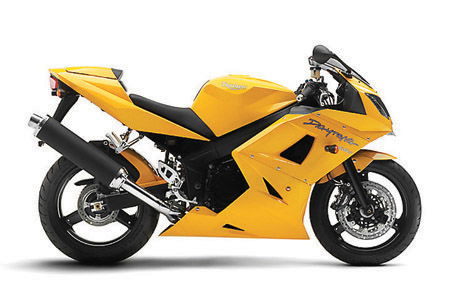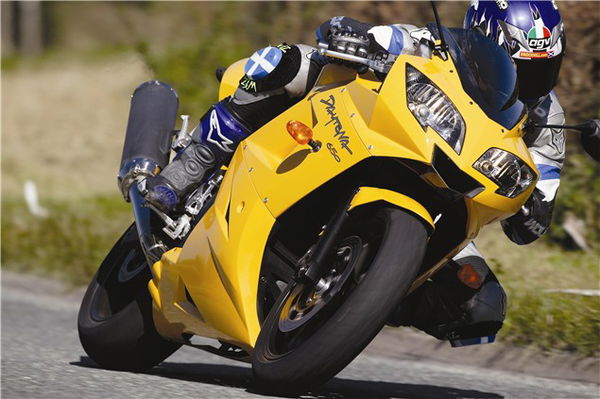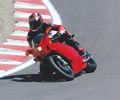First Ride: 2004 Triumph Daytona 650
The Daytona 600 has always had the legs; it's one of the best-handling 600s around. With an extra 47cc - and a load more mid-range - the Daytona 650 might nearly be the perfect middleweight.

 |
When, in 2002 Kawasaki suddenly broke the rules and released the 636cc ZX-6R our British sense of organisation, not to mention fair play, was slightly offended. How can it be a supersport 600 when it isn't 600cc? That's just not cricket, surely that's cheating.
But what actually says that a middleweight sportsbike has to be 600cc? Yes, World Supersport racing dictates a limited capacity but if you have no intention of racing the bike why stick to a capacity limitation? Which is the point Kawasaki proved. The ZX-6R sold well, and as a road bike the extra mid-range was more than useful.
For 2005 Triumph has taken note of this and followed suit with its new Daytona 650. Somewhat given away by the name the new bike is basically a Daytona 600 with a 3.1mm longer stroke engine taking the capacity out 47cc to 646cc.
Why this move? Well unlike Kawasaki, who has a 599cc homologation bike as well as the 636cc model, Triumph are leaving the racing game to concentrate on the road side of things. As a well-place Hinckley insider told me, "the extra capacity has made a huge difference to the Daytona as a road bike and if we kept racing we couldn't have had this. And what would be the point?"
According to Triumph the Daytona 600 is currently its best selling model in the UK, not bad going when you consider how competitive the 600 class is. Against radial brakes, underseat pipes and MotoGP inspired technology the little British firm has stood firm.
And not just in the sales side of things. Group testing the latest 600s the Triumph has always been there or there abouts on track and easily the best day-to-day road bike, although it lacked power. Well, not any more.
After just a few miles on the Daytona 650 I couldn't believe the difference the extra capacity has made to the mid-range. Having owned a Daytona 600 for over 15,000 miles last year I know the bike pretty well and suppose (I should confess) have a slight soft spot for them, but the complete lack of any power below 7000rpm was quite annoying. Not so with the new 650.
Just accelerating in first gear is enough to lift the front wheel in the air. Not violently but a gentle rise as the revs increase, and without any provocation such as snapping the throttle open. From about 5000rpm the new motor drives smoothly with a gentle increase of power; no jumps or kicks, just a gradual build up. It's very impressive and both Niall and myself were surprised at the difference 47cc has made to the sheer usability of a motor.
Niall rightly reckoned; "It took a while to get used to riding a Daytona that didn't require a couple of downshifts for an overtake - and also one that had a gear change that worked well...."It was a major bugbear of the old Daytona that every now and then it would find a false neutral when down changing. To be fair this usually happened on track rather than the road but the gearbox was a weak spot which needed sorting.
Without getting too technical about it (see over the page if you want an in depth description) what Triumph has basically done is swap the direct link from the gearbox spline to the lever to one with a linkage, like most Japanese bikes' gear changes. Which is effectively what adding rearsets did. Problem nicely solved.
Well almost solved. Being a Triumph the gear change is never that smooth, it's just one area the company still has work to do, but the new linkage does make the 650 far more positive changing then the old model. Despite both Niall and myself doing our combined best to get it to jump out of gear it didn't during downshifts on both the road and track, although it wasn't always so good going up the box.
I'm fairly sure that this was just down to it being a new bike with a slightly stiff mechanism, but every now and then it would miss engaging a gear going up. Nothing to really worry about and more miles would help.
The rest of the bike is identical to the old Daytona, which is still one of my favourite bikes around. The chassis is almost as good as the very best of the Japanese and to be truthful it's only on a track and only when you are really hard on it that the differences show. I've watched Niall lap Donington at a terrifying rate on a Daytona and he reckons "the chassis is right up there, if slightly softly sprung for hardcore on-the-edge track lunacy."
But it's this slight softness that makes the Daytona 650 such a good road bike. If the urge takes you it can be taken touring, will deliver 120 miles between fill-ups and once you change the standard screen for one with more height (the standard one is far too low) you can easily sit on the motorway all day long. Try that on a CBR600RR or ZX-6R and you'll need new wrists fairly sharpish...
Verdict
The extra 47cc transforms the Daytona from being a good, but underpowered road bike with polished track handling to an excellent road bike that will flatter any rider on a race track. Unlike some of the Japanese bikes it's not intimidating to ride as the power is delivered in such a smooth, easy to use fashion. It doesn't have a Suzuki's sweet gearbox but it's much improved over the Daytona 600's and is perfectly acceptable.
Then we come to the price. The new 650 is only £150 more than the current Daytona at £6499 (that's a cheap factory fitted hop-up kit) and it should occupy the the same insurance category. And when most of the other sports 600s are topping £7000 the Daytona looks an even more tempting prospect, especially if most of your riding is done on the road rather than the track.
Of course a 2005 model 600 shoot-out (watch this space...) will set the Daytona 650 against its Japanese peers. Whatever the outcome Triumph, finally, has put the finishing touch on its supersports middleweight.
SPECS
TYPE - SUPERSPORTS
PRODUCTION DATE - 2004
PRICE NEW - £6499
ENGINE CAPACITY - 646cc
POWER - 103.8bhp@12,000rpm
TORQUE - 46.2lb.ft@10,000rpm
WEIGHT - 165kg
SEAT HEIGHT - 815mm
FUEL CAPACITY - 18L
TOP SPEED - 165mph
0-60 - n/a
TANK RANGE - N/A

When, in 2002 Kawasaki suddenly broke the rules and released the 636cc ZX-6R our British sense of organisation, not to mention fair play, was slightly offended. How can it be a supersport 600 when it isn't 600cc? That's just not cricket, surely that's cheating.
But what actually says that a middleweight sportsbike has to be 600cc? Yes, World Supersport racing dictates a limited capacity but if you have no intention of racing the bike why stick to a capacity limitation? Which is the point Kawasaki proved. The ZX-6R sold well, and as a road bike the extra mid-range was more than useful.
For 2005 Triumph has taken note of this and followed suit with its new Daytona 650. Somewhat given away by the name the new bike is basically a Daytona 600 with a 3.1mm longer stroke engine taking the capacity out 47cc to 646cc.
Why this move? Well unlike Kawasaki, who has a 599cc homologation bike as well as the 636cc model, Triumph are leaving the racing game to concentrate on the road side of things. As a well-place Hinckley insider told me, "the extra capacity has made a huge difference to the Daytona as a road bike and if we kept racing we couldn't have had this. And what would be the point?"
According to Triumph the Daytona 600 is currently its best selling model in the UK, not bad going when you consider how competitive the 600 class is. Against radial brakes, underseat pipes and MotoGP inspired technology the little British firm has stood firm. And not just in the sales side of things. Group testing the latest 600s the Triumph has always been there or there abouts on track and easily the best day-to-day road bike, although it lacked power. Well, not any more.











